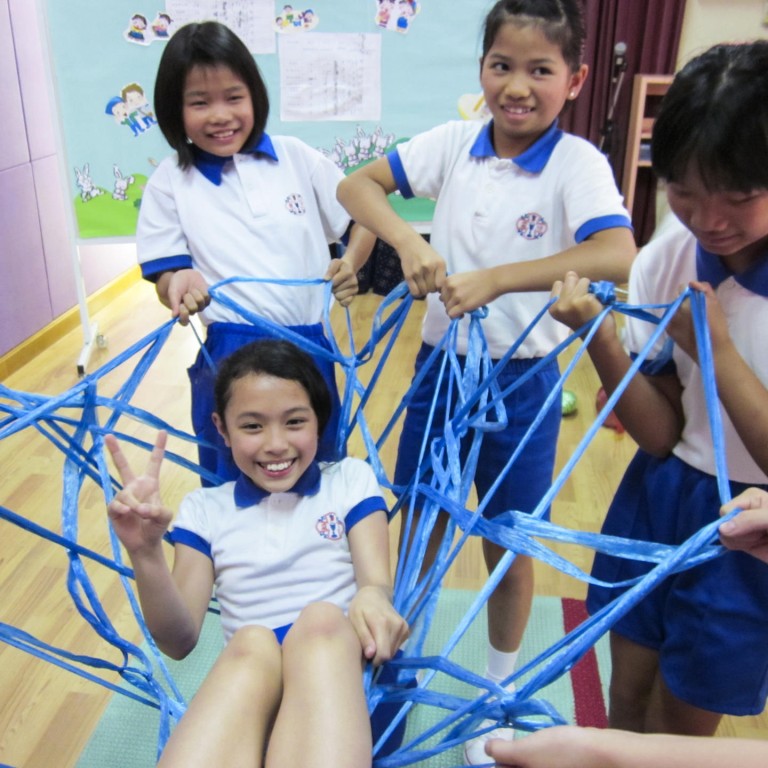
Hong Kong follows Taiwan's lead by teaching life skills alongside academic subjects
With so much emphasis on exam results in Hong Kong schools, some educators have followed Taiwan's lead and begun incorporating life skills into their curriculums, writes Linda Yeung
With a statue of St Mary at the centre of its beautiful courtyard, the Pui Ling School of the Precious Blood in Fanling is abuzz with activity. For 50 minutes every week, students at the Catholic primary school engage in group activities designed to help them learn life lessons.
Pui Ling is at the forefront of a growing trend among schools to incorporate life education into curriculums, reinforcing among students positive values such as gratitude, conservation, team work, caring for others and emotional management.
The school has devised its own curriculum for Primary One to Six, covering 12 themes with associated activities. A theme for upper primary students, for example, focuses on strengthening bonding with teachers and peers.
In groups, students designed posters with information about their teachers for display on campus. They also stacked their shoes to build a tower resembling the Eiffel Tower in Paris. In another activity, students used nylon ropes to build a web to transport eggs around the classroom.
One student wrote on a reflection worksheet afterwards: "We should open up ourselves more in group work. Be bolder and speak louder in sharing ideas. Together we can find out the best option for finishing a task."
Another wrote about the need to overcome his weakness for doing things without thinking them through first.
Since 2002 the school has sought to infuse the non-academic side of learning into its curriculum, but it took time to get the support of the teachers. The programme is finally seeing signs of success as more teachers integrate into their teaching such themes as the value of life, caring for others and sharing with others. In visual arts lessons, for example, Primary Six students recently made fans as gifts to be distributed during visits to homes for the elderly.
"Some of our students come from impoverished families, and they have little self-confidence. But outside school, they provided the best services. At old people's homes, they asked the residents questions and performed magic in front of them. The students that we were most worried about became the most impressive," says principal Wendy Fung Man-yi, a proponent of the life education curriculum.
"What students have learned can have a lifelong impact on them. Today's generation is different from ours. They often go online and have less verbal communication with others. They also spend little time talking with their families."
The ability of students to tackle adversity has also waned, says deputy principal Ada Chu Wai-chun. "We are not trying to change anyone, but we want to give students various perspectives and to let them know that they have us as their company in their growing-up process."
But she says it takes time to get teachers of all subjects to incorporate the values into their lessons. "It can't be rushed," she says. "Initially they had some resistance because they thought there would be difficulties."

Last December, about 30 teachers visited Taiwan, which is well known for its dedication to life education. The trip was organised by the Hong Kong Institute of Education's (HKIEd) Centre for Religious and Spirituality Education, which has been given resources by the Education Bureau to help primary schools with curriculum planning.
Other schools have also come to realise the importance of nurturing students when it comes to self-reflection and positive thinking. Increased provision of resources and support from universities encouraged more schools to take on the additional work.
However, approaches vary from one school to another. Some highlight virtues such as perseverance and frugality in selected modules, while others target particular grades. Others cover it as part of the moral, civic and national education framework endorsed by the Education Bureau.
Josephine Choi Yuen-ying, principal of Alliance Primary School, Whampoa, who was at a recent sharing session at Pui Ling, was impressed by what the school has achieved, but echoed the view that getting teachers involved was not easy. Many face heavy workloads, and often schools and parents put academic results as the top priority.
"We call it spiritual education in our school, and we hope students will share what they have learned with their family," she says. "But it is important to give teachers training so they know what they should aim to achieve and how to go about achieving it."
A survey by the HKIEd centre between March and April among 343 primary and secondary schools reflects a strong need for "character, moral and life education". About 80 per cent of the respondents were worried about students' addiction to smartphones and the ability of students to take care of themselves. A lack of lesson time and difficulties in curriculum planning were cited as the top two hurdles to the extra initiatives.
In another survey, conducted last year by Dr Celeste Yuen, associate professor of HKIEd's department of education policy and leadership, local Chinese students were found to be less happy and have poorer spiritual health than South Asian students, who have struggled with learning in Chinese and generally fare worse academically.
The HKIEd centre estimates that about 20 per cent of primary and 23 per cent of secondary schools respectively are offering life education.
Last month, more than 100 teachers took part in a seminar organised by the centre. Two educators from Taiwan, where primary and secondary schools are required to incorporate life education skills into their curriculums, shared their insights on fostering a positive culture.
